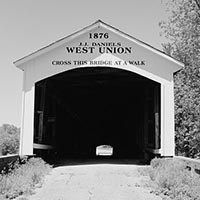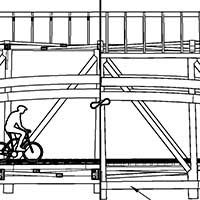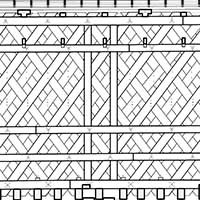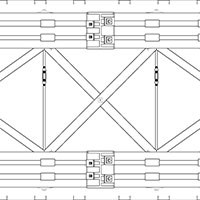HAER Documentation
HAER surveyed over 100 covered bridges as part of the National Covered Bridges Recording Project. The archival documentation produced for these surveys is housed in the HAER Collection at the Library of Congress.
Fly-Through Animation

HAER Engineering Studies

Burr-Arch:
- Gilpin's Falls Covered Bridge (HAER MD-174)
- Pine Grove Bridge (HAER PA-586)
- Strength of Burr-Arch Trusses (HAER OH-138) (additional information)

Town:
- Bath-Haverhill Bridge (HAER NH-33)
- Brown Bridge (HAER VT-28)
- Contoocook Railroad Bridge (HAER NH-38)
- Cornish-Windsor Covered Bridge (HAER NH-8)

Other truss types:
- Childs: Harshman Bridge (HAER OH-126)
- Modified Multiple Kingpost: Taftsville Bridge (HAER VT-30)
- Pratt: Sulphite Railroad Bridge (HAER NH-36)
- Queenpost: Morgan Bridge (HAER VT-33)
- Smith: Cataract Falls Bridge (HAER IN-104)
- Smith: Structural Study of Smith Trusses (HAER PA-645)

Additional studies:
- Analyzing Covered Bridge Floor Systems (HAER NH-53) (additional information)
- Covered Bridge Educational Models (HAER MD-190)
Final Set of HAER Engineering Studies
Analyzing Covered Bridge Floor Systems (HAER NH-53)

Significance: It has been observed that current methods of calculating the strength of the timber floor systems of covered bridges seem to underestimate the actual strength of these systems to a greater extent than would be explained by the factors of safety used in conventional calculations. If so, historic covered bridge systems may be unnecessarily replaced, or load limits may be set so low that bridge replacement becomes probable. To explore apparent differences between current design practices and actual floor performance, researchers instrumented the floor of a Town lattice covered bridge with transducers and then drove a heavy truck of known weight across the span while resulting strains in floor components were recorded. Researchers then studied the strains to discern whether interactions between the trusses, joists and deck were strengthening the joists. The team varied floor system parameters (such as type and density of fasteners, deck thickness, and test vehicle speed) during the test in an effort to determine what factors most significantly affected strains in the floor components.
Authors: James Barker, VS Engineering; Timothy Andrews, Barns and Bridges of New England; Matthew Reckard; Christopher H. Marston, 2019.
Project Information: The project was authorized under Task Agreement Number P14AC01504 of Cooperative Agreement Number P14AC01002, originally signed September 2014. James Barker of VS Engineering led the research and wrote the report under a contract with the National Society for the Preservation of Covered Bridges (William Caswell, President). Timothy Andrews of Barns and Bridges of New England built the full-size model Town lattice truss bridge. Matthew Reckard completed additional research and compiled the bibliography. Joe Vangampler prepared graphics and arranged the report.
Download the Survey: HAER NH-53 is available via the Library of Congress.
Moose Brook Bridge (HAER NH-48)

Significance: The Moose Brook Bridge is one of six boxed pony truss bridges remaining in North America. This former rail line contributed to the economic development of Coos County and the growth of tourism in the White Mountains.
Authors: Lola Bennett (history), 2009; Dario Gasparini and Kamil Nizamiev (engineering), 2018; Timothy Andrews (reconstruction); Vern Mesler (brazing); Christopher H. Marston (editor), 2019.
Project Information: Christopher H. Marston, HAER Architect, served as project leader from 2009-19. The 2009 HAER field team consisted of Anne E. Kidd, field supervisor; Jeremy T. Mauro and Bradley M. Rowley, architects; and Csaba Bartha, ICOMOS intern (Romania); Lola Bennett, historian; and Jet Lowe, photographer. The National Society for the Preservation of Covered Bridges (NSPCB, David Wright, president until he died in 2014) offered the bridge for the research project. Timothy Andrews of Barns and Bridges of New England (BBofNE) disassembled the bridge in 2010, and reconstructed the trusses in 2011-2012, assisted by Will Truax. Vern Mesler led the braze welding repair of the castings at Lansing Community College in 2011. Dario Gasparini led the engineering research on the trusses at Case Western Reserve University, from 2011-2014, assisted by staff Kamil Nizamiev, Neil Harner, Jim Berilla, Michael Butler, and David Conger; and students Vincent Marvin, Lin Wan, and Janette Siu. In 2013, HAER completed laser scanning of the trusses, with a field team consisting of Jeremy T. Mauro, field supervisor; Pavel Gorokhov, Ben Shakelton, and Hummam Salih, architects. Under a Phase II agreement with the NSPCB (William Caswell, president since 2014), Timothy Andrews reassembled the trusses at the Wiscasset, Waterville and Farmington Railway Museum (WW&F David J. Buczkowski, president) in 2017-18.
Download the Survey: HAER NH-48 is available via the Library of Congress.
Strength of Burr-Arch Trusses (HAER OH-138)

Significance: Beginning about 1804, Theodore Burr (1771-1822) built wooden covered bridges that combined a multiple-kingpost truss with an arch into one structural form. The Burr-arch truss is now the most common type in the inventory of extant nineteenth-century covered bridges in the United States. However, there is considerable variability in the geometric parameters and details used for actual bridges. Results of a survey of thirty Burr-arch truss bridges were used to design and fabricate a 2/3-scale symmetry model of a Burr-arch truss. This model was load-tested to investigate the behavior of Burr-arch trusses at strength. The overall observations from the tests are that strength is connection-controlled, flaw-controlled, and generally brittle. Some general principles of strength limit state analyses of structural systems are presented in the context of Burr-arch trusses.
Authors: Dario Gasparini, Stacey Hursen, Gregory Willenkin, Kamil Nizamiev, Case Western Reserve University, 2015.
Project Information: The Strength of Burr-Arch Trusses research project was facilitated through Cooperative Agreement No. P10AC00630, between NPS and CWRU. Christopher H. Marston, HAER Architect, served as project leader. Prof. Dario Gasparini developed and led the research, with engineering students Stacey Hursen, Gregory Willenkin, and Kamil Nizamiev, all of Case Western Reserve University. Rudy Christian constructed the truss model, assisted by his wife Laura and Andrew Schaeffer. David Simmons, James Cooper, Campbell Fitzhugh, and Linda Gasparini assisted with the survey of Burr-arch truss bridges in Ohio, Indiana, and Pennsylvania.
Download the Survey: HAER OH-138 is available via the Library of Congress.
Supplemental Materials: The following files are provided for use in the peer-review process. We will post them in a different format for public use once the study is published. The video and photographs show the load-testing of the Burr-arch truss model on May 21, 2015. Both focus on the moment of failure, when the model was loaded to the maximum load of 68.8 kips.
- Video of the load-testing experiment (.wmv, 129 MB). Right-click the link and save it to your computer. The file opens in Windows Media Player.
- Photo sequence of the rupture (pdf, 4.7 MB). This photo sequence can be viewed like a "flip book" when opened in Adobe Acrobat or Adobe Reader, outside of a web browser.
Last updated: June 14, 2022


